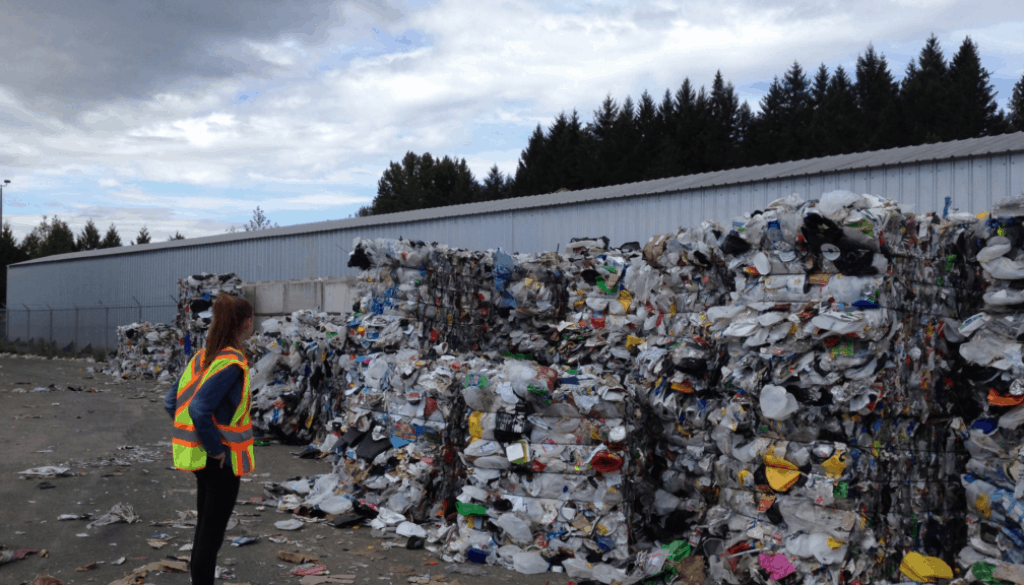Recyclable and recycling are not one and the same yet are often used interchangeably. What are the differences between the two words and why is it important to use them correctly?
RECYCLABLE
Let’s start with recyclable. The Federal Trade Commission “Green Guides” § 260.12 (2012) states ”A product or package should not be marketed as recyclable unless it can be collected, separated, or otherwise recovered from the waste stream through an established recycling program for reuse or use in manufacturing or assembling another item”. It is most commonly associated with the chasing arrows on plastic packaging. Often with a number present inside the chasing arrows, this symbolizes what type of plastic was used to make said product or package. Some plastic such as PET (number 1) and HDPE (number 2) can easily be recycled, while others such as PVC cannot be recycled. While the material in theory may be recyclable that does not mean the item actually gets recycled. Take aluminum for example. Aluminum is in theory infinitely recyclable. However, according to the U.S. Environmental Protection Agency, in 2018 aluminum beer and soft drink cans were recycled at a rate of 50.4% (Advancing Sustainable Materials Management: 2018 Tables and Figures, 2020). This raises the question, if a material is theoretically infinitely recyclable why is it not recycled at or close to 100%?
RECYCLING
Whether or not the item gets recycled depends on several factors; feasibility, profitability and strength of end markets, and contamination to name a few.
Feasibility
How easy is the item to recycle? This means consumer access to recycling, sorting by consumers, and current infrastructure capabilities. 53% of households in the United States have access to curbside recycling automatically (Sustainable Packaging Coalition, 2016). If consumers are required to separate packaging components, it’s more likely the consumer will throw the item in the trash versus taking the extra time to separate components. If current infrastructure has difficulty recognizing a material and/or the item requires additional processing to separate multiple parts this could cause the item to end up in the landfill as well.
Profitability & End Markets
Additional time and money spent sorting items decreases the profitability of recycling for Materials Recovery Facilities (MRFs) and reprocessors. Profitability and strength of end markets go hand in hand. If there is little to no end market for a recycled material, there is no profit in recycling said material.
Contamination
There are two categories of contamination; contamination caused by consumers and contamination caused by manufacturers. The consumer contamination is caused by a lack of understanding of the recycling process leading to confusion and wishcycling. Whereas the contamination caused by manufacturers is a result of the materials used in creating the item.
Confusion – Recycling regulations vary state to state in the United States. There is a lack of consistency not only in the U.S. but around the world. One region may accept plastic bottles with lids on, another with lids off. One region may accept plastic tubs used to contain butter, yogurt, etc. while another region may not.
Wishcycling – Consumers think if they put something in the magical blue recycle bin that item will be recycled. More often than not, these items wreak havoc at MRFs and reprocessors. There is a disconnect between consumers and the journey items undergo the moment they get thrown in the blue bin. The moment the item enters the blue bin, the consumer is done with the item and it’s now another person’s (or country’s) problem.
On the manufacturer side, multi-material items, mis-leading labels, and unwanted components like shrink sleeves, adhesives, etc. can cause contamination at MRFs and reprocessors. Consider a multi-material package that is made of paper and aluminum. Separately these materials are recyclable, together it becomes difficult. The paper reprocessors do not want aluminum and vice versa.
The answers to these factors largely depend on location. This is why EcoImpact-COMPASS users select a region for modeling their packaging.
It is important to keep feasibility, strength of end markets and profitability, and contamination in mind when designing packaging and products. Pre-populated end-of-life percentages within EcoImpact-COMPASS guide users in designing for real-world end-of-life scenarios early in the design phase. When it works, recycling is a valuable way to conserve resources and producers play a large role in the process.
Trayak has been helping leading brands of all sizes make data-driven sustainability decisions for over 10 years. If you would like to learn more about our tools and services please contact us.
Prashant Jagtap founded Trayak with the vision of bringing sustainability mainstream. Trayak’s mission is to provide easy-to-use software decision tools that enable design & manufacturing of sustainable products and packaging.
For over 25 years Prashant has worked with leading international brands and global manufacturers from different industries to help improve their product and package development and launch processes.
As President/CEO of Trayak, he routinely consults with leading companies to reduce their product & package environmental footprints. He has conducted many workshops and webinars on the use of screening Life Cycle Analysis and Sustainability Scoring to simulate, reduce, track and report on environmental footprints. Prashant holds a Master’s in Manufacturing Systems Engineering from UMASS at Amherst, MA and an MBA from Xavier University, Cincinnati, OH.







